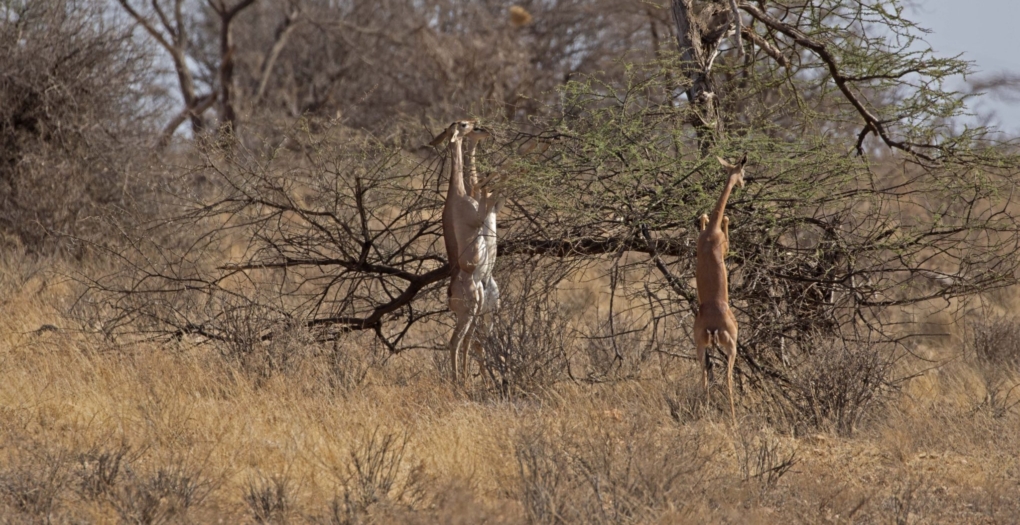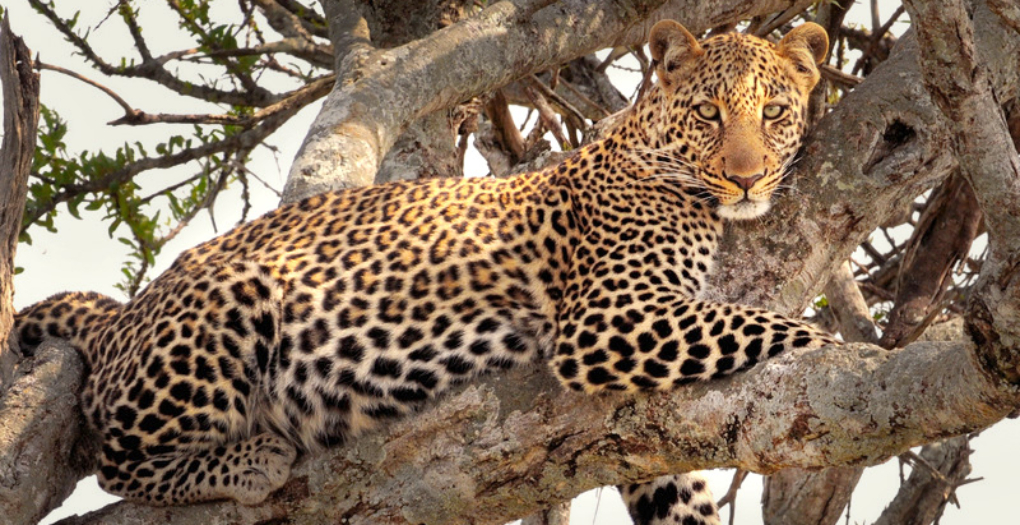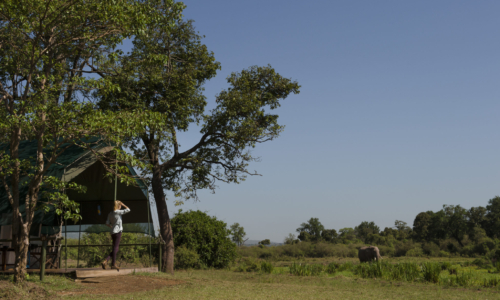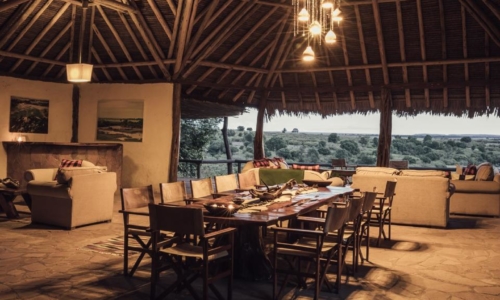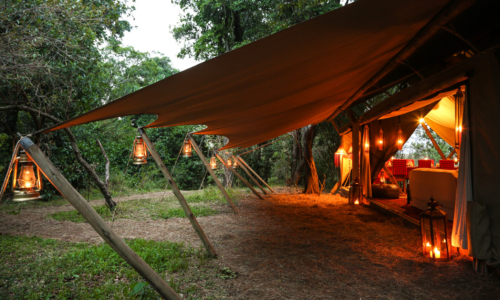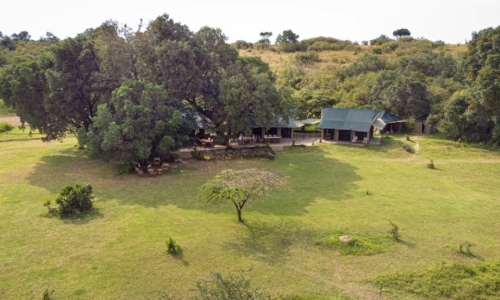The Samburu National Reserve forms a part of a far larger wildlife conservation area which includes the Buffalo Springs National Reserve to the south, and the Shaba National Reserve to the east between which the resident wildlife freely roams. The park covers an area of about 102 miles. The Ewaso Nyiro River is a big draw for the animals. It flows from the Kenyan highlands and empties into the Lorian Swamp. The park includes a mixture habitats from acacia, to riverine forest, to thorn trees, as well as grassland. The Koitogor and Ololokwe mountains provide a dramatic backdrop to the plains. The park neighbors the homes of the Samburu tribe of Kenya, who are known for their remote culture and nomadic way of life. Because it was inaccessible for a long time, the reserve still retains an air of serenity.
The reserve boasts a diverse array of wildlife due to the lush vegetation and water available from the Ewaso Nyiro River. The reserve even features some rare northern species known as the Samburu Special Five: Grevy zebra, Somali ostrich, reticulated giraffe, gerenuk, and the beisa oryx. A popular elephant destination, there are at least 900 living here. Large predators such as the lion, leopard and cheetah are never far behind the grazing herbivores. Wild dogs are a common sight here too. An abundance of bird life can be found in the reserve with over 450 species including lesser kestrel, taita falcon, African darter, great egret, white-headed vulture, martial eagle, and the yellow-billed ox-pecker. Plus, it is home to the critically endangered pancake tortoise. However, the reserve is most famous for being one of the two areas in which conservationists, George and Joy Adamson raised Elsa the Lioness. Their story was documented in the bestselling book and award-winning movie “Born Free”.
Kenyan safari lodges in Samburu National Reserve include the Samburu Sopa Lodge, Saruni Samburu, Elephant Bedroom Camp, Samburu Game Lodge, SaSaab Camp, as well as the luxurious and eco-friendly Larsens Tented Camp. Game drives can be arranged at these camps with great opportunities to spot wildlife, especially in the dry season when they converge on the river, which also hosts Nile crocodiles. Bird-watching safaris are a photographer’s dream come true.
Visits to local Samburu villages provide more cultural understanding of the people who live here as well as an opportunity to purchase traditional Samburu art and souvenirs. There are also opportunities to explore the reserve up close by taking a bush walk or mountain biking. While the park is open year-round, it is best to visit during its two dry seasons: from December to March and again from June to October.


- Amboseli Serena Safari Lodge
- Basecamp Masai Mara
- Bateleur Camp
- Campi ya Kanzi
- Cottar’s 1920s Safari Camp
- Deloraine House
- Eagle View
- Elephant Bedroom Camp
- Elephant Pepper Camp
- Elsa’s Kopje
- Emboo
- Encounter Mara
- Governors’ Camp
- Governors’ Private Camp
- Hemingways Ol Seki Mara Camp
- House in the Wild
- Il Moran Camp
- Il Ngwesi
- Joy’s Camp
- Kicheche Bush
- Kicheche Laikipia
- Kicheche Mara
- Kicheche Valley
- Kichwa Tembo Tented Camp
- Kifaru House Lewa
- Kilaguni Serena Safari Lodge
- Kinondo Kwetu
- Kitich Camp
- Kitirua Plains Lodge
- Lake Elmenteita Serena Camp
- Leopard Hill
- Lewa House
- Lewa Private Wilderness
- Lewa Safari Camp
- Lewa Wilderness Lodge
- Little Governors’ Camp
- Loisaba Lodo Springs
- Loisaba Star Beds
- Loisaba Tented Camp
- Loldia House
- Mahali Mzuri
- Mara Expedition Camp
- Mara Nyika
- Mara Plains Camp
- Mara Serena Safari Lodge
- Mara Toto Tree Camp
- Mfangano Island Camp
- Naboisho Camp
- Ngare Serian
- Offbeat Mara Camp
- Ol Donyo Lodge
- Ol Jogi
- Ol Pejeta Bush Camp
- Ol Pejeta House
- Olare Mara
- Ololo Safari Lodge
- Olonana
- Olonana – Geoffrey Kent Suite
- Rekero Camp
- Reteti House
- Sabuk Lodge
- Sala’s Camp
- Sand River Masai Mara
- Sarara Camp
- Sarara Treehouses
- Sarara Wilderness
- Saruni Mara
- Saruni Rhino
- Saruni Samburu
- Saruni Wild
- Sasaab Camp
- Segera Retreat
- Serian The Original
- Serian’s Nkorombo
- Sirikoi
- Solio Lodge
- Sosian Lodge
- Speke’s Camp
- Tambarare
- Tangulia Mara
- Tawi Lodge
- Tortilis Camp
- Wilderness Mara
- Amboseli Serena Safari Lodge
- Basecamp Masai Mara
- Bateleur Camp
- Campi ya Kanzi
- Cottar’s 1920s Safari Camp
- Deloraine House
- Eagle View
- Elephant Bedroom Camp
- Elephant Pepper Camp
- Elsa’s Kopje
- Emboo
- Encounter Mara
- Governors’ Camp
- Governors’ Private Camp
- Hemingways Ol Seki Mara Camp
- House in the Wild
- Il Moran Camp
- Il Ngwesi
- Joy’s Camp
- Kicheche Bush
- Kicheche Laikipia
- Kicheche Mara
- Kicheche Valley
- Kichwa Tembo Tented Camp
- Kifaru House Lewa
- Kilaguni Serena Safari Lodge
- Kinondo Kwetu
- Kitich Camp
- Kitirua Plains Lodge
- Lake Elmenteita Serena Camp
- Leopard Hill
- Lewa House
- Lewa Private Wilderness
- Lewa Safari Camp
- Lewa Wilderness Lodge
- Little Governors’ Camp
- Loisaba Lodo Springs
- Loisaba Star Beds
- Loisaba Tented Camp
- Loldia House
- Mahali Mzuri
- Mara Expedition Camp
- Mara Nyika
- Mara Plains Camp
- Mara Serena Safari Lodge
- Mara Toto Tree Camp
- Mfangano Island Camp
- Naboisho Camp
- Ngare Serian
- Offbeat Mara Camp
- Ol Donyo Lodge
- Ol Jogi
- Ol Pejeta Bush Camp
- Ol Pejeta House
- Olare Mara
- Ololo Safari Lodge
- Olonana
- Olonana – Geoffrey Kent Suite
- Rekero Camp
- Reteti House
- Sabuk Lodge
- Sala’s Camp
- Sand River Masai Mara
- Sarara Camp
- Sarara Treehouses
- Sarara Wilderness
- Saruni Mara
- Saruni Rhino
- Saruni Samburu
- Saruni Wild
- Sasaab Camp
- Segera Retreat
- Serian The Original
- Serian’s Nkorombo
- Sirikoi
- Solio Lodge
- Sosian Lodge
- Speke’s Camp
- Tambarare
- Tangulia Mara
- Tawi Lodge
- Tortilis Camp
- Wilderness Mara

The Samburu National Reserve forms a part of a far larger wildlife conservation area which includes the Buffalo Springs National Reserve to the south, and the Shaba National Reserve to the east between which the resident wildlife freely roams. The park covers an area of about 102 miles. The Ewaso Nyiro River is a big draw for the animals. It flows from the Kenyan highlands and empties into the Lorian Swamp. The park includes a mixture habitats from acacia, to riverine forest, to thorn trees, as well as grassland. The Koitogor and Ololokwe mountains provide a dramatic backdrop to the plains. The park neighbors the homes of the Samburu tribe of Kenya, who are known for their remote culture and nomadic way of life. Because it was inaccessible for a long time, the reserve still retains an air of serenity.
The reserve boasts a diverse array of wildlife due to the lush vegetation and water available from the Ewaso Nyiro River. The reserve even features some rare northern species known as the Samburu Special Five: Grevy zebra, Somali ostrich, reticulated giraffe, gerenuk, and the beisa oryx. A popular elephant destination, there are at least 900 living here. Large predators such as the lion, leopard and cheetah are never far behind the grazing herbivores. Wild dogs are a common sight here too. An abundance of bird life can be found in the reserve with over 450 species including lesser kestrel, taita falcon, African darter, great egret, white-headed vulture, martial eagle, and the yellow-billed ox-pecker. Plus, it is home to the critically endangered pancake tortoise. However, the reserve is most famous for being one of the two areas in which conservationists, George and Joy Adamson raised Elsa the Lioness. Their story was documented in the bestselling book and award-winning movie “Born Free”.
Kenyan safari lodges in Samburu National Reserve include the Samburu Sopa Lodge, Saruni Samburu, Elephant Bedroom Camp, Samburu Game Lodge, SaSaab Camp, as well as the luxurious and eco-friendly Larsens Tented Camp. Game drives can be arranged at these camps with great opportunities to spot wildlife, especially in the dry season when they converge on the river, which also hosts Nile crocodiles. Bird-watching safaris are a photographer’s dream come true.
Visits to local Samburu villages provide more cultural understanding of the people who live here as well as an opportunity to purchase traditional Samburu art and souvenirs. There are also opportunities to explore the reserve up close by taking a bush walk or mountain biking. While the park is open year-round, it is best to visit during its two dry seasons: from December to March and again from June to October.

- Amboseli Serena Safari Lodge
- Basecamp Masai Mara
- Bateleur Camp
- Campi ya Kanzi
- Cottar’s 1920s Safari Camp
- Deloraine House
- Eagle View
- Elephant Bedroom Camp
- Elephant Pepper Camp
- Elsa’s Kopje
- Emboo
- Encounter Mara
- Governors’ Camp
- Governors’ Private Camp
- Hemingways Ol Seki Mara Camp
- House in the Wild
- Il Moran Camp
- Il Ngwesi
- Joy’s Camp
- Kicheche Bush
- Kicheche Laikipia
- Kicheche Mara
- Kicheche Valley
- Kichwa Tembo Tented Camp
- Kifaru House Lewa
- Kilaguni Serena Safari Lodge
- Kinondo Kwetu
- Kitich Camp
- Kitirua Plains Lodge
- Lake Elmenteita Serena Camp
- Leopard Hill
- Lewa House
- Lewa Private Wilderness
- Lewa Safari Camp
- Lewa Wilderness Lodge
- Little Governors’ Camp
- Loisaba Lodo Springs
- Loisaba Star Beds
- Loisaba Tented Camp
- Loldia House
- Mahali Mzuri
- Mara Expedition Camp
- Mara Nyika
- Mara Plains Camp
- Mara Serena Safari Lodge
- Mara Toto Tree Camp
- Mfangano Island Camp
- Naboisho Camp
- Ngare Serian
- Offbeat Mara Camp
- Ol Donyo Lodge
- Ol Jogi
- Ol Pejeta Bush Camp
- Ol Pejeta House
- Olare Mara
- Ololo Safari Lodge
- Olonana
- Olonana – Geoffrey Kent Suite
- Rekero Camp
- Reteti House
- Sabuk Lodge
- Sala’s Camp
- Sand River Masai Mara
- Sarara Camp
- Sarara Treehouses
- Sarara Wilderness
- Saruni Mara
- Saruni Rhino
- Saruni Samburu
- Saruni Wild
- Sasaab Camp
- Segera Retreat
- Serian The Original
- Serian’s Nkorombo
- Sirikoi
- Solio Lodge
- Sosian Lodge
- Speke’s Camp
- Tambarare
- Tangulia Mara
- Tawi Lodge
- Tortilis Camp
- Wilderness Mara
- Amboseli Serena Safari Lodge
- Basecamp Masai Mara
- Bateleur Camp
- Campi ya Kanzi
- Cottar’s 1920s Safari Camp
- Deloraine House
- Eagle View
- Elephant Bedroom Camp
- Elephant Pepper Camp
- Elsa’s Kopje
- Emboo
- Encounter Mara
- Governors’ Camp
- Governors’ Private Camp
- Hemingways Ol Seki Mara Camp
- House in the Wild
- Il Moran Camp
- Il Ngwesi
- Joy’s Camp
- Kicheche Bush
- Kicheche Laikipia
- Kicheche Mara
- Kicheche Valley
- Kichwa Tembo Tented Camp
- Kifaru House Lewa
- Kilaguni Serena Safari Lodge
- Kinondo Kwetu
- Kitich Camp
- Kitirua Plains Lodge
- Lake Elmenteita Serena Camp
- Leopard Hill
- Lewa House
- Lewa Private Wilderness
- Lewa Safari Camp
- Lewa Wilderness Lodge
- Little Governors’ Camp
- Loisaba Lodo Springs
- Loisaba Star Beds
- Loisaba Tented Camp
- Loldia House
- Mahali Mzuri
- Mara Expedition Camp
- Mara Nyika
- Mara Plains Camp
- Mara Serena Safari Lodge
- Mara Toto Tree Camp
- Mfangano Island Camp
- Naboisho Camp
- Ngare Serian
- Offbeat Mara Camp
- Ol Donyo Lodge
- Ol Jogi
- Ol Pejeta Bush Camp
- Ol Pejeta House
- Olare Mara
- Ololo Safari Lodge
- Olonana
- Olonana – Geoffrey Kent Suite
- Rekero Camp
- Reteti House
- Sabuk Lodge
- Sala’s Camp
- Sand River Masai Mara
- Sarara Camp
- Sarara Treehouses
- Sarara Wilderness
- Saruni Mara
- Saruni Rhino
- Saruni Samburu
- Saruni Wild
- Sasaab Camp
- Segera Retreat
- Serian The Original
- Serian’s Nkorombo
- Sirikoi
- Solio Lodge
- Sosian Lodge
- Speke’s Camp
- Tambarare
- Tangulia Mara
- Tawi Lodge
- Tortilis Camp
- Wilderness Mara











